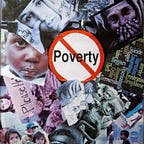What Is a Poverty Line?
The poverty threshold, poverty limit, poverty line or breadline, is the minimum level of income deemed adequate in a particular country. The poverty line is usually calculated by finding the total cost of all the essential resources that an average human adult consumes in one year. The largest of these expenses is typically the rent required for accommodation, so historically, economists have paid particular attention to the real estate market and housing prices as a strong poverty line effect. Individual factors are often used to account for various circumstances, such as whether one is a parent, elderly, a child, married, etc. The poverty threshold may be adjusted annually. In practice, like the definition of poverty, the official or common understanding of the poverty line is significantly higher in developed countries than in developing countries.
David Gordon’s paper, “Indicators of Poverty and Hunger”, for the United Nations, further defines absolute poverty as the absence of any two of the following eight basic needs:[25]
- Food: Body mass index must be above 16.
- Safe drinking water: Water must not come solely from rivers and ponds, and must be available nearby (fewer than 15 minutes’ walk each way).
- Sanitation facilities: Toilets or latrines must be accessible in or near the home.
- Health: Treatment must be received for serious illnesses and pregnancy.
- Shelter: Homes must have fewer than four people living in each room. Floors must not be made of soil, mud, or clay.
- Education: Everyone must attend school or otherwise learn to read.
- Information: Everyone must have access to newspapers, radios, televisions, computers, or telephones at home.
- Access to services: This item is undefined by Gordon, but normally is used to indicate the complete panoply of education, health, legal, social, and financial (credit) services.
Most people who care about measuring poverty — academics, policymakers, nonprofit leaders, and the like — agree that the way the federal government currently determines who is poor and who is not doesn’t work. The so-called “poverty line” was determined in the mid-1960s by calculating the amount of money it costs to buy a basic basket of food and then multiplying that amount by three. Each year the line is updated to account for inflation. (The current poverty line is $12,880 for a single person and $26,500 for a family of four.) If a person lives in a household whose income is less than that amount, he is considered poor. If the household’s income is that amount or more (even by one dollar), he is not poor.
The measure does not consider other living costs besides food, and the federal poverty line is the same whether a person lives in New York City or McAlester, Okla.
The federal poverty line is used to determine eligibility and appropriations for all types of federal, state, and local aid, including food stamps, Temporary Assistance for Needy Families (TANF), and Medicaid. How the line is determined has real material implications for low-income families. The poverty line is also the most important way that America measures how well it is treating its most disadvantaged members. A large and growing percentage of people below the poverty line indicates that we are not doing enough. A small and declining percentage of people in poverty tells us that we might be on the right track.
Now is the time to improve our measures of poverty. But the current conversation around Bloomberg’s initiative and other proposals to update how we measure poverty falls into the same trap by reducing the complexity of poverty to a single figure, a line. If our goal is to achieve a better measure of well-being in order to diagnose human needs and design effective solutions, no line — no matter how thoughtful or sound — will do.
Resources
Wikipedia Contributors. (2021, July 24). Poverty threshold. Wikipedia; Wikimedia Foundation. https://en.wikipedia.org/wiki/Poverty_threshold
Beyond the Poverty Line (SSIR). (2021). Ssir.org. https://ssir.org/articles/entry/beyond_the_poverty_line
